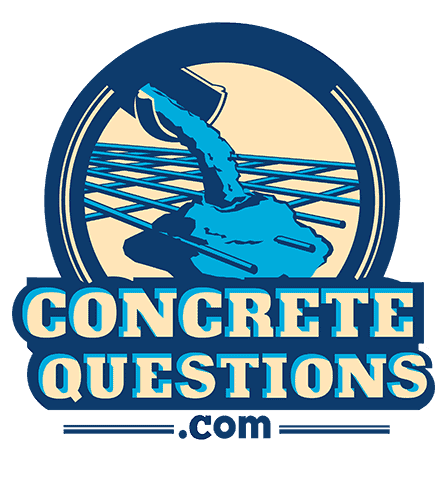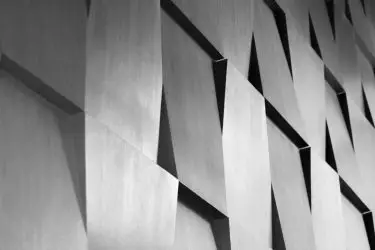Pools are all about recreation and relaxation, whether you’re swimming laps or leisurely lounging in the water. There are different types of pools, with concrete and fiberglass pools being the most common. Each type of pool has different characteristics from the other.
Concrete pools are highly durable, easily customizable, and simple to install. They are made with a supporting steel framework to provide more strength. Fiberglass pools are prefabricated with a mold in the factory and have limited designs and styles, though they’re far more affordable.
This article will help you understand what concrete and fiberglass pools are, their main components, and their pros and cons.
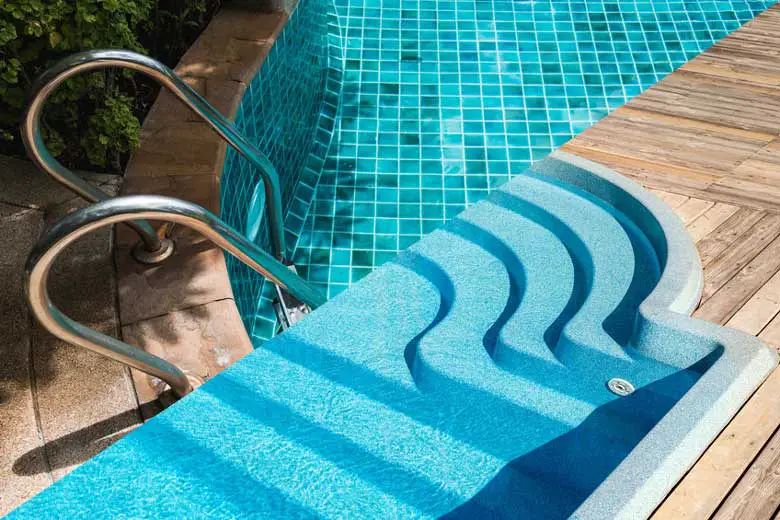
Table of Contents
Concrete Pool: A Basic Overview
A concrete pool is a type of inground swimming pool construction that holds water for recreation or relaxation. It is the popular choice of pool for standard sports and competition pools because they’re long-term investments.
Concrete pools are popular among pool owners due to their durability, customization, and better aesthetic value compared to other types of pools.
They are hardy and require a high amount of pressure to make them flake. Also, they’re not too difficult to construct for a professional and can adapt to accommodate unique designs and pool features.
However, it is necessary to mention that its durability and pleasing appearance come at a high cost and long construction time. It is also the costliest inground swimming option when it comes to maintenance.
Read more: Cost of A Concrete In-Ground Pool (With 35+ Real Examples)
Despite its overall strength, it has low tensile strength—its surface breaks off easily when stretched or bent. This low strength gives rise to the rough pool wall and floor surfaces that may be a source of worry (but can also be fixed).
Components of Concrete Pools
The durability of concrete pools is a product of the components that are used in their construction. Concrete, though often used interchangeably as cement, is not cement. Concrete is the end product obtained from mixing several micro-ingredients such as cement, soil, water, rocks, etc.
The strength of concrete determines how long the pool will last, and it is common to see concrete pools that have lasted for up to twenty years.
Some of these components also give concrete pools their characteristic ability to allow different designs and finishes.
For a better understanding, here are the components of a concrete pool:
Cement
Cement is the major component of concrete. It should not be mistaken as concrete, as it needs to combine with other elements to form solid concrete.
In making concrete, cement usually makes up the highest percentage by volume. This proportion ensures that the resulting concrete has a tremendous withstanding strength against the forces of water, the earth, and gravity that can cause it to fall apart over time. In other words, the more cement the concrete contains, the stronger it is.
Sand
Sand is another component of a concrete mix. It is critical because it adds volume to the mix and further strengthens it. Although cement ordinarily comprises limestone, silica, sand, and clay, it needs more sand to hold it together.
Sand improves the strength of concrete by preventing air passage through the mix. It achieves this by filling pores that remain in the mixture of cement and coarse aggregates.
Being of finer aggregate, it binds the cement to the coarse aggregate.
Coarse Aggregate
The coarse aggregate used in classic concrete making could be either gravel or stones. Their coarseness has nothing to do with the size; it is more about the rock or stone’s hardness.
Gravel or stone, used in concrete swimming pool construction, is usually small-sized for smoothness and easy finishing. As such, bigger gravel or rocks makes it difficult to finish the pool.
The coarse aggregate adds more strength to the concrete mix and contributes to the concrete swimming pool’s durability.
Water
Water, unlike cement and coarse aggregates, does not add strength to the concrete mix. It does not combine well with cement.
You’ve probably noticed that water seeps out of a mortar or concrete mix when left to sit for some time. It does the same when used in a concrete pool.
Water essentially makes concrete pouring easier. It also helps to hold the other components of the concrete mix in place until the cement solidifies and holds in the coarse aggregates and sand.
The water in the mixture is usually lost to the atmosphere.
Steel
Steel is used to create the framework that defines the concrete mix’s shape and design. Recall that concrete has excellent strength but low tensile strength.
To compensate for its weak tensile strength, builders use steel frameworks to form webs that hold the concrete in place and give it additional strength.
With the steel framework, they can achieve the desired shape and design.
Concrete Pool Construction
A concrete pool is made using all the above-listed components, and it involves some technicalities that you will understand soon.
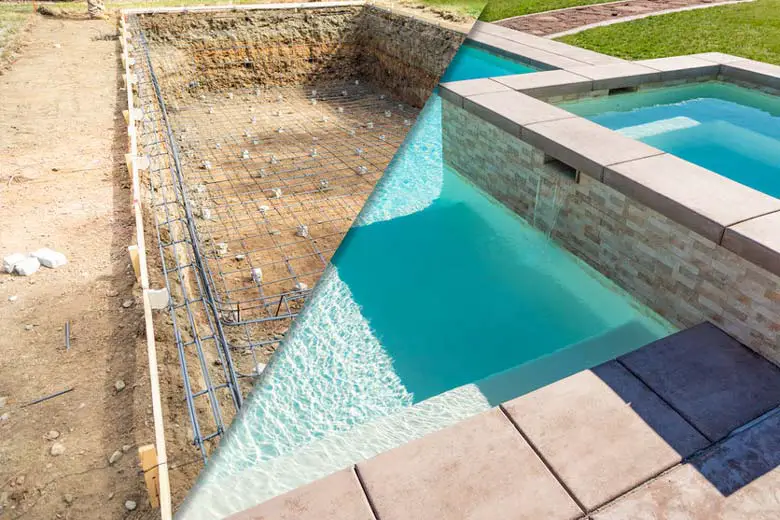
Since it is usually an inground pool, some digging is necessary. But the depth comes down to personal choice!
It is best to select a suitable site for your pool before construction begins. Your site should not be at the bottom of a hill or slope. Otherwise, dirt and other debris might wash into it during or after a windy day or rain storm.
It is also a good idea to have portions of your yard with utility cables or pipes marked out. Keep in mind that this might affect the size and shape of your desired pool design.
Don’t forget about other features (such as the pump and diving board) when choosing an appropriate space.
Also read: This Is How Concrete Pools Are Made
Here are the procedures involved in constructing a concrete swimming pool:
Excavation
Excavation is the first step in the actual construction process. Builders dig the hole and either transport the dirt away from the site or use it on other projects.
The depth of the excavation depends on your choice, and during this phase, all contours of design are exposed.
It is important to note that the excavation’s width should not affect the pool’s proposed width, keeping in mind that the concrete will be at least 6 inches (15 cm) thick.
Factor the concrete’s thickness into the hole’s width.
Leveling
In this phase, you’ll remove the excavated soil from the edge of the now-coming-around pool. It is done either using a steel-toothed rake to level the pool floor or a builder’s trowel to level the walls.
Be sure to respect the design while doing this, as it might erase a slope in your design. This phase is crucial as it is part of the foundation of the pool. A level foundation produces a strong and evenly distributed strength.
Steel Placement
The steel used in concrete pool construction is rods. They are bent to conform with the shape of the excavation.
Also, a little allowance is left between the framework formed by the steel and the hole’s walls and base.
The steel is placed there to reinforce the earth and the concrete. It supports the concrete and helps it attain its desired shape despite its low tensile strength.
However, you need to place the steel rods in a criss-cross pattern and bind each one to an adjoining one with steel ropes.
Plumbing
The plumbing of the concrete pool is placed behind the steel framework. It is the part of the structure that supplies and filtrates water that goes into the pool.
Some of the plumbing is installed before the steel framework.
However, there are parts of the plumbing that require the support of the framework. Professionals must test the plumbing and steel framework integrity before the next step to avoid waste of resources.
Shell Placement
The shell of the pool is concrete. It is made by using a hose to spray gunite or shotcrete into the pool’s shape.
Gunite is a dry mix of cement, sand, and stones. It mixes with water in the hose and forms a paste that adheres to the pool walls and floor.
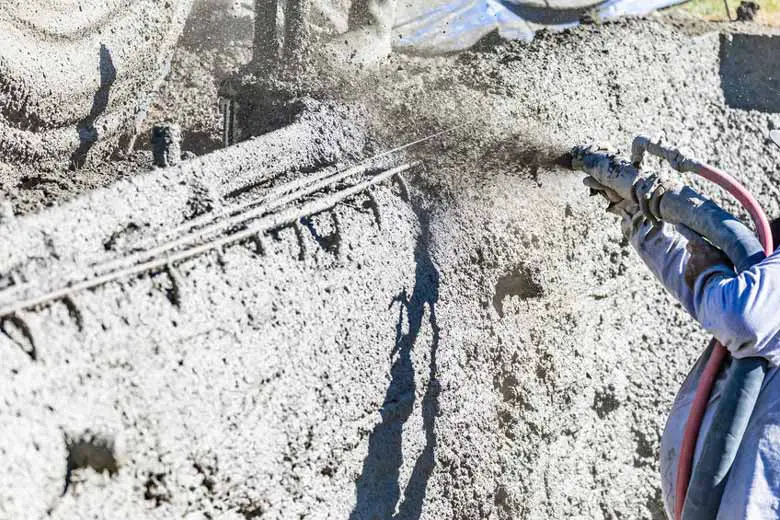
Read more: Gunite vs. Concrete: Here Are the Differences
On the other hand, shotcrete is a mix of cement, sand, stones, and water. It has water in its mix before it gets to the sprayer.
The concrete shell is sprayed generously into the pool to attain a thickness of at least 6 inches (15 cm).
Curing
Concrete does not necessarily dry out. Instead, it cures.
Curing is the hydrolyzation of specific molecules present in the concrete mix. Although you shouldn’t add too much water to a concrete mix while you’re preparing it, water is vital to make it stronger after laying it.
The curing process for a concrete pool takes about 28 days, which is the longest part of the entire construction process.
To achieve curing, water the pool about 3 to 4 times daily. Alternatively, you can spread damp canvas over the concrete and water it regularly that way.
Waterproofing
Concrete is porous. Therefore, you need to waterproof it. After smoothening the concrete surface and leaving it to cure, clean the surface of the concrete shell and spray, roll, or paint it with waterproof material, like a concrete sealer.
Also read: Do You Need to Seal the Concrete Around a Pool?
Tiling and Coping
The most common type of pool finishing material is tiles. Builders can also use other materials such as glass and ceramic.
Cover the concrete shell with tiles all the way up to the top of the pool. Use the same material to cover the floor of the pool as well. It further waterproofs the concrete and improves its appearance.
Coping is done around the border of the pool. It is the arrangement of stone or concrete around the perimeter of the pool. Choose your coping material well as it is the transition from patio to pool.
Pool Start-Up
Your pool is now ready, but first, you must start it up. This stage is the last before you can begin to use your concrete swimming pool safely. It involves filling the pool with water to check for water chemical levels.
During this period (which usually lasts for ten days), you need to scrub the pool walls to remove all plaster dust. You should not turn on the pool water heater until the plaster dust has been removed.
Pros of Concrete Pool
Concrete pools have some advantages over every other type of pool. For anyone who has owned or owns one, it is not far-fetched.
However, for those who are yet to decide on the type of pool they should get, here are some reasons to get the concrete pool:
- Durability: The foremost advantage a concrete pool has over every other type of pool is its durability. This quality is attributed to the cement-stone-sand mixture’s strength, enforced by the steel framework to withstand the earth’s forces, gravity, and water. On average, a concrete pool lasts for as long as 20 years.
- Aesthetics: Concrete pools allow for the best types of designs and finishes. From the pool floor to its lip and extending to the patio, designs pleasing to the eyes can be used.
- Flexibility: Concrete pools can be customized to your taste, including any feature you want, and give you satisfaction since you will be getting value for your money.
Cons of Concrete Pool
- High Cost: Concrete pools are pretty amazing. However, they can cost an arm and a leg. To get a quality concrete swimming pool, you need to have a budget of $50,000 and above. Some can also cost as high as $100,000. Not everyone who wants a swimming pool can afford that amount.
- High maintenance: Yes, concrete pools are durable and robust. However, they are also costly to maintain. They require refinishing every few years. The concrete is porous; therefore, it’s prone to algae that needs to be removed as regularly as possible. A thorough brushing of the pool once a week is recommended by professionals.
- Long construction time: It takes a while to get a concrete pool done. Every process that leads to the final product takes an average of 2 days. However, stages like curing and pool start-up take 28 and 10 days, respectively. Together, the construction of a concrete pool can take up to 50 days or more.
Fiberglass Pool: A Brief Overview
Fiberglass pools are premade pools, which could be in-ground or on the surface, made out of fiberglass.
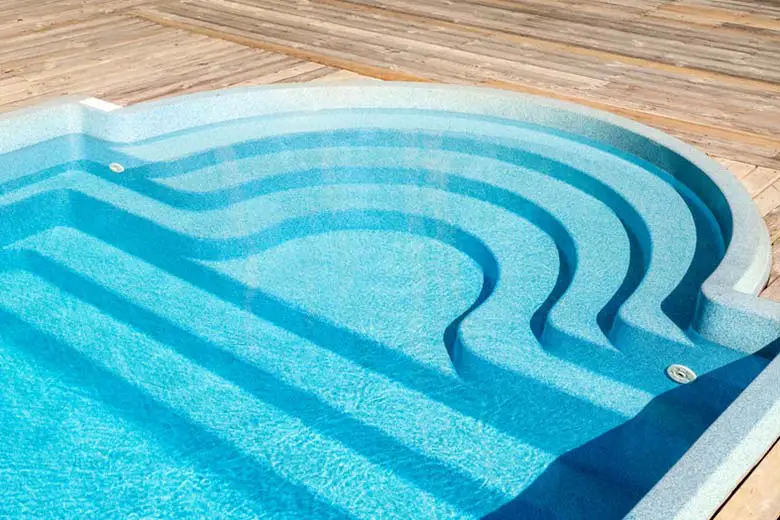
Fiberglass is a material commonly used to produce sinks, bathtubs, airplanes, and other high-performance devices. It is made from interwoven glass threads covered with polyester resin.
Because it is premade, it takes less time to install a fiberglass pool and costs a considerably lesser amount to purchase and ultimately install. It is also cheaper to maintain compared to other types of pools.
The process of making fiberglass pools is usually not visible to buyers (like a concrete pool). However, you can watch the installation in your yard!
How Is a Fiberglass Pool Made?
Fiberglass pools are made using a mold to carve out the shape of the pool. Although different manufacturers use different process sequences, they essentially use the same materials and have similar results.
There are three steps in manufacturing a fiberglass pool.
- Plug or pattern production: The pattern is the process by which the shape of the pool shell is made. It is made with fiberglass, wood, primer, and body filler. Due to the technicality that goes into its production, it takes about four months for the pattern to be ready. When it is, release agents and liquid sealers are applied to the design to remove the mold.
- Mold production: The mold is made of fiberglass. It has a brightly colored exterior and steel frame in its interior. Once it is removed from the pattern, the mold is flipped over to prepare the surface and facilitate the pool shell release. The bright color of the mold’s exterior exposes any part of it that fails to adhere to the Gelcoat. Mold production takes about four weeks to complete.
- Pool shell production: The last stage of the fiberglass pool manufacture process takes about two days. It involves the use of straps connected to the pool shell to pull it off the mold.
Fiberglass Pool Components
Now that you know how the pattern, mold, and pool shell of fiberglass pools are made, you might be wondering about the components that make up these pools.
Manufacturers of fiberglass pools usually use fiberglass in different layers to produce the pool shell.
Here are some components of a fiberglass pool, more accurately, the pool shell:
- Gelcoat: The Gelcoat is the inner surface of the pool shell. It is the part that is exposed to you after pool installation. Over time, it hardens through polymerization and creates a waterproof layer in the pool. The Gelcoat is smooth and does not encourage the growth of algae.
- Resin: Two types of resins are used to produce the fiberglass pool shell. The vinyl ester resin is not affected by pool water, unlike the polyester resin. It is, therefore, used as a glue to keep the fiberglass layer between the Gelcoat and the polyester resin layer together. The vinyl ester resin beneath the Gelcoat and the polyester resin layers help to avoid osmotic blisters. The polyester resins are used to glue the chopped fiberglass.
- Chopped fiberglass: These are the parts of the pool shell that provide strength to the pool shell. It helps to maintain the integrity and shape of the pool shell as the mold forms it. It is the part held together by the polyester resin.
- Plumbing: The plumbing is the part of the pool that supplies water to the pool sheet and makes it useful for its purpose. With a fiberglass pool, the pool sheet has straps that hold the plumbing around it to avoid settlement.
Installation of Fiberglass Pool
The installation of the fiberglass pool follows the procedure below.
- Excavation: This process involves the removal of the soil to fit the prefabricated pool shell. As in a concrete pool, the ground removed must be big enough to fit the pool shell’s size and shape. Don’t forget to remove enough soil that allows some extra room around the pool shell when installed.
- Leveling: This stage involves the smoothening of the floor and walls of the excavation. The uneven undulations on the walls and bottom of the excavated area are removed by using a trowel. You should level the floor and walls to ensure even strength distribution in the pool shell.
- Plumbing: The fixtures carry water and purify it into the pool shell. Plumbing is usually done before the pool shell is transferred into the excavated area. Professionals should handle the plumbing as it can get tricky. Ensure that the plumbing system agrees with the design of the fiberglass pool shell. Some water inlets might be at the bottom-center of the pool shell, while some might be at either side of the bottom.
- Pool shell installation: Now that the plumbing is done accurately, it is time to put it in the pool shell. It should sit comfortably on the leveled floor and leave allowance between itself and the excavated soil walls. The plumbing should agree with the holes provided for it on the pool shell.
- Coping and patio: The patio is an extension of the pool. Set stones or tiles on the patio to increase the aesthetic appeal of the pool. The coping or lip of the pool should also be set with stones to provide a guide.
- Pool fence installation: Fill back the allowances around the pool shell with concrete. Sometimes, the concrete might be poured to hold some plumbing in place and avoid shifting. After the fill-back, construct the pool deck and fencing to provide a guide around the pool.
- Pool start-up: This stage entails the filling of the pool shell with water to enable it to do its job. Unlike concrete pools, fiberglass pools do not require ten days to scrub plaster dust. It also does not raise concerns about water chemicals. Fiberglass pools are ready to use once the installation is complete.
Pros of Fiberglass Pool
- Easy maintenance: Fiberglass pools are smooth and are not porous. This feature makes them easy to clean and discourages the growth of algae. Also, it costs less to maintain fiberglass pools compared to concrete pools.
- Durability: Although not as durable as concrete pools, fiberglass pools last long as the interwoven glass materials don’t damage easily.
- Saltwater system compatibility: Saltwater causes cracks in concrete pools. However, fiberglass pools are resistant to salt. This feature makes them suitable for use in saltwater systems.
- Fast installation: It takes a relatively short time to install fiberglass pool shells. Most time spent in the manufacture of fiberglass pool shells happens in the factory. However, its installation takes a few days or weeks, at most.
- Lesser cost: Fiberglass pools cost less to install than concrete pools. It is possible to get a fiberglass pool installed with a budget of less than $50,000.
Cons of Fiberglass Pool
- Limited styles and designs: Since the fiberglass pool shells are premade, the varieties that exist in size and design are limited. You will only get designs and sizes whose mold is already available in the factory.
- Relatively costly: Although it is not as costly as concrete pools, it is more expensive than vinyl pools. While you can get one for less than $50,000, some options are above that price and come close to the cost of installing a concrete pool.
Differences Between Concrete Pools and Fiberglass Pools
As seen so far in the article, there are some apparent differences between concrete pools and fiberglass pools.
Here are the main differences:
- Cost: The cost of concrete pools is on the high side. A budget of about $50,000 is the minimum required price for the construction of a concrete pool. Prices as high as $100,000 are not unheard of. Fiberglass pools cost relatively less than concrete pools. They can cost as high as concrete pools but are generally less expensive.
- Duration of installation: It takes months to construct a concrete pool to completion. The processes involved in the construction of concrete pools take time to complete. Fiberglass pools take less time to install. The longest time in its manufacture is spent in the factory. This period does not affect the duration of its installation.
- Maintenance: Maintaining a concrete pool is an arduous task due to the porous nature of concrete. It takes a lot of effort to remove algae growth in concrete pools. It is also costly to maintain concrete pools. Fiberglass pools, on the other hand, require less stress in removing algae. It also costs less to maintain fiberglass pools.
- Durability: Concrete pools are generally more durable than fiberglass pools. The concrete mix and the underlying steel framework provide unmatched strength in the concrete pool. However, fiberglass pools are strong and durable, but not as much as concrete pools.
- Aesthetics: It is easier to accomplish various designs and styles with concrete pools. However, designs and styles are limited in fiberglass pools.
Conclusion
The type of pool you settle for will depend on the features you’re looking for. Concrete pools and fiberglass pools are both in-ground pools. However, fiberglass pools can be used as surface pools as well.
Concrete pools are durable and robust. They are made with a mix of concrete components and an underlying web of steel for increased strength.
The concrete’s porous character makes it difficult to clean out algae, leading to a high maintenance cost. It also needs periodic refinishing to remove the surface roughness.
Fiberglass pools are relatively less costly and are easier to maintain.
